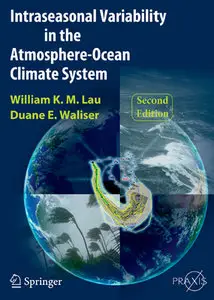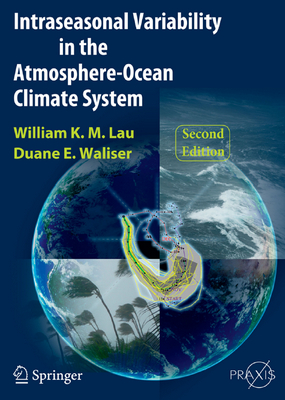"Intraseasonal Variability in the Atmosphere–Ocean Climate System" ed. by William K. M. Lau and Duane E. Waliser
Second Edition
Sрringеr Science Business Media, Prаxis Publishing | 2012 | ISBN: 3642139132 9783642139130 9783642139147 | 641 pages | PDF | 26 MB
Second Edition
Sрringеr Science Business Media, Prаxis Publishing | 2012 | ISBN: 3642139132 9783642139130 9783642139147 | 641 pages | PDF | 26 MB
This book is intended to be a one-stop reference book for researchers interested in ISV as well as a textbook for senior undergraduate and graduate students in Earth science disciplines.
The chapters are written with self-contained material and frequent cross-referencing to other chapters, so that they need not be read in sequence. Readers are encouraged to jump to their chapters of interest if they so desire.
Contents
Preface
Preface to the First Edition
List of figures
Abbreviations
1 Historical perspective (Roland A. Madden and Paul R. Julian)
1.1 Introduction
1.2 The intraseasonal, tropospheric oscillation
1.3 The elementary 4-D structure
1.4 Other early studies of the oscillation
1.5 The oscillation in 1979
1.6 Complexity of cloud movement and structure
1.7 Seasonal variations in the oscillation
1.8 The oscillation in the zonal average
1.9 Other effects of the oscillation
1.10 Summary
1.11 References
2 South Asian monsoon (B. N. Goswami)
2.1 Introduction
2.1.1 South Asian summer monsoon and active/break cycles
2.1.2 Amplitude and temporal and spatial scales
2.1.3 Regional propagation characteristics
2.1.4 Relationship between poleward-propagating ISOs and monsoon onset
2.1.5 Relationship with the MJO
2.2 Mechanism for temporal-scale selection and propagation
2.2.1 30 to 60-day mode
2.2.2 10 to 20-day mode
2.3 Air–sea interactions
2.4 Clustering of synoptic events by ISOs
2.5 Monsoon ISOs and predictability of the seasonal mean
2.6 Aerosols and monsoon ISOs
2.7 Predictability and prediction of monsoon ISOs
2.8 Summary and discussion
2.9 Acknowledgments
2.10 Appendix
2.11 References
3. Intraseasonal variability of the atmosphere–ocean–climate system: Asian monsoon (Huang-Hsiung Hsu)
3.1 Introduction
3.2 General characteristics of EA/WNP monsoon flow
3.3 Periodicity, seasonality, and regionality
3.4 Intraseasonal oscillation propagation tendency
3.5 Relationship with monsoon onsets and breaks
3.6 The 10 to 30-day and 30 to 60-day boreal summer ISO
3.6.1 The 30 to 60-day northward/northwestward-propagating pattern
3.6.2 The 10 to 30-day westward-propagating pattern
3.7 Relationship with tropical cyclone activity
3.8 Upscale effect of TC and synoptic systems
3.9 Final remarks
3.9.1 Close association with the EA/WNP monsoon
3.9.2 The CISO vs. interannual variability
3.9.3 Multiperiodicities and multiscale interaction
3.9.4 Others
3.10 References
4. Pan America (Kingtse C. Mo, Charles Jones, and Julia Nogue´s Paegle)
4.1 Introduction
4.2 Variations in the IS band
4.3 IS variability in December–March
4.3.1 EOF modes
4.3.2 The Madden Julian Oscillation
4.3.3 The submonthly oscillation
4.4 IS variability in June–September
4.4.1 EOF modes
4.4.2 Madden–Julian Oscillation
4.4.3 Submonthly oscillation
4.5 Intraseasonal modulation of hurricanes
4.6 Summary
4.7 References
5. Australasian monsoon (M. C. Wheeler and J. L. McBride)
5.1 Introduction
5.2 Seasonal cycle of background flow
5.3 Broadband intraseasonal behavior: Bursts and breaks
5.4 Broadband intraseasonal behavior: Spectral analysis
5.5 Meteorology of the bursts and breaks
5.6 Characteristics and influence of the MJO
5.7 1983/1984 and 1987/1988 case studies
5.8 MJO influence on monsoon onset
5.9 Other modes and sources of ISV
5.10 Modulation of tropical cyclones
5.11 Extratropical–tropical interaction
5.12 Prediction
5.13 Conclusions
5.14 References
6. The oceans (William S. Kessler)
6.1 Introduction
6.2 Heat fluxes
6.2.1 Salinity and the barrier layer
6.2.2 A 1-D heat balance?
6.2.3 The role of advection
6.3 Vertical structure under westerly winds
6.4 Remote signatures of wind-forced Kelvin waves
6.5 El Nin˜ o and rectification of ISV
6.6 ISV in the Indian Ocean
6.6.1 Differences between the Indian and Pacific Ocean warm pools and their consequences
6.6.2 Oscillations lasting about 60 days in the western equatorial Indian Ocean
6.6.3 Recent models of wind-forced ISV in the Indian Ocean
6.7 Other intrinsic oceanic ISV
6.7.1 Global ISV
6.7.2 Non-TISO-forced ISV in the tropical Indo-Pacific
6.7.3 ISV outside the equatorial Indo-Pacific
6.8 Conclusion
6.9 References
7. Air–sea interaction (Harry Hendon)
7.1 Introduction
7.2 Air–sea fluxes for the eastward MJO
7.3 Air–sea fluxes associated with northward propagation in Indian summer monsoon
7.4 SST variability
7.5 Mechanisms of SST variability
7.6 SST–atmosphere feedback
7.7 Impact of slow SST variations on MJO activity
7.8 Concluding remarks
7.9 Acknowledgments
7.10 References
8. Mass, momentum, and geodynamics (Benjamin F. Chao and David A. Salstein)
8.1 Introduction
8.2 Angular momentum variations and Earth rotation
8.2.1 Length-of-day variation and axial angular momentum
8.2.2 Polar motion excitation and equatorial angular momentum
8.2.3 Angular momentum and torques
8.3 Time-variable gravity
8.4 Geocenter motion
8.5 Conclusions
8.6 Acknowledgments
8.7 References
9. El Nino Southern Oscillation connection (William K. M. Lau)
9.1 Introduction
9.2 A historical perspective
9.3 Phase 1: The embryonic stage
9.3.1 OLR time–longitude sections
9.3.2 Seasonality
9.3.3 Supercloud clusters
9.3.4 Early modeling framework
9.4 Phase 2: The exploratory stage
9.4.1 MJO and ENSO interactions
9.4.2 WWEs
9.5 Phase 3: ENSO case studies
9.5.1 El Nin˜ o of 1997/1998
9.5.2 Stochastic forcings
9.6 Phase-4: Recent development
9.6.1 A new ISO index
9.6.2 Composite events
9.6.3 The ISV–ENSO biennial rhythm
9.7 TISV and predictability
9.8 Acknowledgments
9.9 References
10. Theories (Bin Wang)
10.1 Introduction
10.2 Review of ISO theories
10.2.1 Wave CISK
10.2.2 Wind–evaporation feedback or WISHE
10.2.3 Frictional convergence instability (FCI)
10.2.4 Cloud–radiation feedback
10.2.5 Convection–water vapor feedback and the moisture mode
10.2.6 Multiscale interaction theory
10.2.7 Mechanisms of the boreal summer intraseasonal
oscillation
10.2.8 Atmosphere–ocean interaction
10.3 A general theoretical framework
10.3.1 Fundamental physical processes
10.3.2 Governing equations
10.3.3 Boundary layer dynamics near the equator
10.3.4 The 1.5-layer model for the MJO
10.3.5 The 2.5-layer model including the effects of basic flows
10.4 Dynamics of the MJO
10.4.1 Low-frequency equatorial waves and the associated Ekman pumping
10.4.2 Frictional convergence instability (FCI)
10.4.3 FCI mode under nonlinear heating
10.4.4 The role of multiscale interaction (MSI) in MJO dynamics
10.5 Dynamics of boreal summer ISO
10.5.1 Effects of mean flows on the ISO
10.5.2 Mechanism of northward propagation
10.6 Role played by atmospheric–ocean interaction
10.7 Summary and discussion
10.7.1 Understanding gained from the FCI theory
10.7.2 Model limitations
10.7.3 Outstanding issues
10.8 Acknowledgments
10.9 References
11. Modeling intraseasonal variability (K. R. Sperber, J. M. Slingo, and P. M. Inness)
11.1 Introduction
11.2 Modeling the MJO in boreal winter
11.2.1 Interannual and decadal variability of the MJO
11.2.2 Sensitivity to formulation of the atmospheric model
11.2.3 Modeling the MJO as a coupled ocean–atmosphere phenomenon
11.3 Boreal summer intraseasonal variability
11.3.1 GCM simulations
11.3.2 Air–sea interaction and boreal summer intraseasonal variability
11.3.3 Modeling studies of the links between boreal summer intraseasonal and interannual variability
11.4 The impact of vertical resolution in the upper ocean
11.5 Concluding remarks
11.6 Acknowledgments
11.7 References
12 Predictability and forecasting (Duane Waliser)
12.1 Introduction
12.2 Empirical models
12.3 Dynamical forecast models
12.4 Predictability
12.5 Real time forecasts
12.6 Discussion
12.7 Appendix
12.8 Acknowledgments
12.9 References
13 Africa and West Asia (Mathew Barlow)
13.1 Overview
13.2 Summary of Africa research
13.2.1 West Africa
13.2.2 Eastern Africa
13.2.3 Southern Africa
13.3 Summary of West Asia research
13.4 Station data analysis
13.4.1 Methodology and data
13.4.2 Nairobi
13.4.3 Riyadh
13.5 Relevance of Gill–Matsuno dynamics and the role of mean wind
13.6 Summary and discussion
13.7 References
14 Tropical–extratropical interactions (Paul E. Roundy)
14.1 Introduction
14.2 A boreal winter composite of the global flow associated with the MJO
14.3 Response of the global atmosphere to heating in tropical convection
14.4 Influence of extratropical waves on tropical convection
14.5 Two-way interactions between the tropics and extratropics
14.6 MJO influence on the predictability of the global flow
14.7 Discussion
14.8 References
15 Oceans and air–sea interaction (Jean Philippe Duvel)
15.1 Introduction
15.2 The source of SST intraseasonal perturbations
15.2.1 Observed ISV of the SST
15.2.2 Source of the ISV of SST
15.2.3 SST perturbations over the SCTR
15.3 Air–sea processes for the simulation and predictability of ISV
15.3.1 Passive response of the atmosphere to the ISV of SST
15.3.2 Coupled simulations, air–sea fluxes, and SST feedback
15.4 Air–sea processes and scale interaction
15.4.1 The diurnal cycle
15.4.2 Interannual variability and the Indian Ocean Dipole
15.5 Discussion
15.6 Acknowledgments
15.7 References
16 Vertical structure from recent observations (Chidong Zhang)
16.1 Introduction
16.2 Remote-sensing products
16.3 References
17 Multiscale theories for the MJO (Andrew J. Majda and Samuel N. Stechmann)
17.1 Introduction
17.2 The MJO skeleton
17.3 Multicloud and multiscale effects
17.3.1 Kinematic models for the MJO
17.3.2 Dynamic models for waves in the MJO
17.4 Implications for global circulation models
17.5 Summary
17.6 References
18 Chemical and biological impacts (Baijun Tian and Duane E. Waliser)
18.1 Introduction
18.2 Ozone
18.3 Aerosols
18.4 Carbon monoxide
18.5 Ocean chlorophyll
18.6 Looking ahead
18.7 Acknowledgments
18.8 References
Index
with TOC BookMarkLinks



